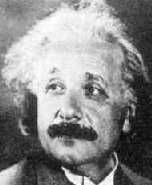
Albert Einstein was born on March 14, 1879 in Ulm, Germany to middle-class Jews.
In 1886 Einstein started schooling in Munich. He disliked the drilling in school and preferred to study at home. He had violin lessons and was taught Judaism. Later he entered the Luitpold Gymnasium. He studied mathematics, in particular the calculus.
In 1901 he managed to avoid Swiss military service because he had flat feet and varicose veins.
In 1905 Einstein earned a doctorate from the University of Zurich for a thesis "On a new determination of molecular dimensions".
In 1921 Einstein received the Nobel Prize but not for relativity rather for his 1905 work on the photoelectric effect. In fact he was not present in December 1922 to receive the prize as he was on a voyage to Japan.
In 1935 he applied and was granted permanent residency in the United States. At Princeton his work attempted to unify the laws of physics.
Albert Einstein tried to combine electromagnetic and gravitational phenomena in a single theory, called the Unified Field Theory. Although he spent the last 25 years of his life working on it he failed to establish this theory.
Einstein is arguably the greatest theoretical physicist who ever lived.
On April 18, 1955, at the age of 76, Einstein died peacefully.
The Special Theory Of Relativity
Postulate 1:
Observers can never detect their uniform motion except relative to other objects.
The Laws of Physics look the same to all observers as long as they are not accelerating.
Postulate 2:
The speed of light is the same for all observers regardless of their relative motions.
Some Features of Special Relativity:
speed of light (c) is the speed limit for matter.
mass increases with increasing velocity.
time slows down with increasing velocity.
length decreases with increasing velocity.
mass and energy are interchangeable.
The General Theory of Relativity
Principle of Equivalence: Observers cannot distinguish locally between forces due to acceleration and forces due to gravitation.
Modern Statement of GR: Matter tells space-time how to curve; Space-time tells matter how to move.
Some Features of General Relativity:
space-time is curved in the vicinity of matter.
time slows down in the presence of gravitational fields.
light is deflected in gravitational fields.
Return